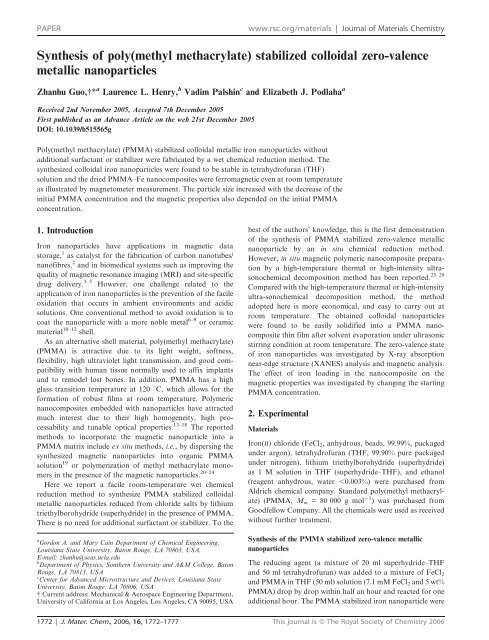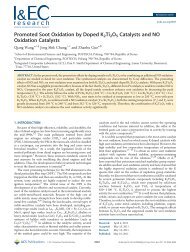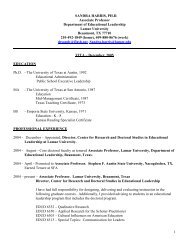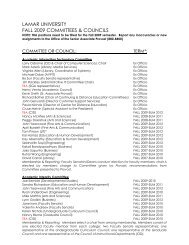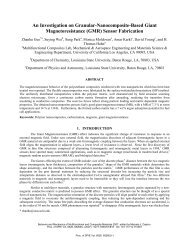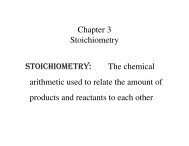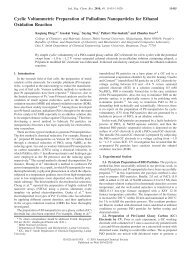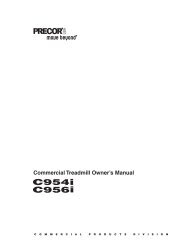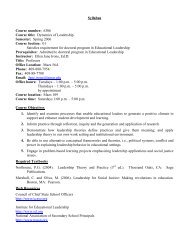Synthesis of poly(methyl methacrylate) stabilized ... - Lamar University
Synthesis of poly(methyl methacrylate) stabilized ... - Lamar University
Synthesis of poly(methyl methacrylate) stabilized ... - Lamar University
- No tags were found...
You also want an ePaper? Increase the reach of your titles
YUMPU automatically turns print PDFs into web optimized ePapers that Google loves.
Fig. 2 Fe K-edge XANES spectra <strong>of</strong> the bcc iron foil, PMMA<strong>stabilized</strong> iron nanoparticles and iron oxides.Fig. 1 (a) TEM bright field micrograph <strong>of</strong> PMMA <strong>stabilized</strong> ironnanoparticles from high initial PMMA concentration (5 wt%) (Insetshows the selected area electron diffraction); and (b) particle sizedistribution (Inset shows lattice fringe with 0.2 nm lattice spacing).provided. Due to the low concentration <strong>of</strong> iron nanoparticlesin the PMMA–Fe nanoparticle complex, X-ray diffractiondidn’t show any observable crystalline peaks. Therefore,XANES was used to investigate the valence state <strong>of</strong> ironnanoparticles and the samples were prepared in the glove box.Fig. 2 shows the Fe K-edge XANES spectra <strong>of</strong> PMMA<strong>stabilized</strong> iron nanoparticles, bcc iron foil, and iron oxidesas references. Based on such factors as the position <strong>of</strong> theabsorption edge, the intensities <strong>of</strong> the pre-edge and white linefeatures, and other resonances at higher energy, the nanoparticlespectrum is very similar to that <strong>of</strong> the bcc foil anddifferent from any <strong>of</strong> the iron oxides. This observationindicates that the synthesized iron nanoparticles have bccstructure without oxidation. It also indicates that the ironnanoparticles are stable in the ethanol solvent during thewashing process, unlike the iron oxidation in the goldcoated iron nanoparticles obtained from the microemulsiontechnique. 40It was reported that the superhydride is a strong reducingagent and can reduce esters, amides and other potentiallydesirable ligand functional groups. 41,42 As an ester-groupmember, (–C(O)OR9), PMMA was anticipated to be reducedby superhydride. The effect <strong>of</strong> the superhydride on PMMAand the possible physicochemical interaction between the ironnanoparticles and PMMA were tested by FT-IR. The spectra<strong>of</strong> the pure PMMA and the synthesized PMMA <strong>stabilized</strong>powder nanoparticles are shown in Fig. 3. The sharp absorptionat 1732 cm 21 corresponds to CLO groups; 43,44 the peaksat 1149 and1192 cm 21 are due to the C–H deformations, and1242 and 1269 cm 21 peaks represent C–C–O stretch coupledwith C–O stretch in PMMA. 43 The similarity <strong>of</strong> the spectrabetween the pure PMMA and the PMMA <strong>stabilized</strong> nanoparticleindicates that superhydride had an insignificant effecton the PMMA and the iron nanoparticles were effectively<strong>stabilized</strong> by PMMA. In other words, PMMA was not reducedby the superhydride. The shift <strong>of</strong> the peak toward lowerwavenumbers was an indicator <strong>of</strong> the chemical bonding <strong>of</strong>surfactant onto the nanoparticle surface. 45,46 There is almostno change in the peaks (wavenumbers) between the pureFig. 3 FT-IR spectra <strong>of</strong> pure PMMA and PMMA <strong>stabilized</strong> ironnanoparticles with PMMA concentration <strong>of</strong> 5 wt% and 1 wt%.1774 | J. Mater. Chem., 2006, 16, 1772–1777 This journal is ß The Royal Society <strong>of</strong> Chemistry 2006
free from oxidation, which is consistent with the XANESanalysis and recent report on <strong>poly</strong>(ethylene glycol) <strong>stabilized</strong>iron nanoparticles. 29The effect <strong>of</strong> iron nanoparticle loading was studied bychanging the initial PMMA concentration in the reactantsolution. Here, 1 wt% was used instead <strong>of</strong> 5 wt%. The ironnanoparticle concentration was about 54.9 wt% determined byatom absorption analysis. Fig. 5 (a) shows the TEM brightfield micrographs and Fig. 6 shows the magnetic properties,respectively. The PMMA concentration was observed to havea dramatic effect on the size <strong>of</strong> the iron nanoparticles. Atlower PMMA concentration, the nanoparticle size was about23.5 nm ¡ 7.5 nm, which is much bigger than that in thehigher PMMA concentration. The particle size distribution isshown in Fig. 5 (b). The electron diffraction spot rather thanthe ring pattern indicates a bigger particle size, consistent withthe TEM observation. The almost overlapping ZFC and FChysteresis loops indicate that there is no obvious oxidation inthe iron nanoparticles. As determined from Fig. 6, thecoercivity was 58 Oe at 300 K and 161 Oe at 10 K, respectively.Fig. 6 Hysteresis loops <strong>of</strong> PMMA <strong>stabilized</strong> Fe nanoparticles at300 K, and at 10 K in both zero field cooled and field cooled at 5 T(ZFC and FC hysteresis loops are almost overlapping at 10 K); the leftinset shows the partially enlarged hysteresis loops and the right insetshows the ZFC and FC temperature dependent magnetizationnormalized by magnetization at 340 K measured at a constant field<strong>of</strong> 100 G.The saturation magnetization (based on the iron weightpercentage) was calculated to be 184.4 emu g 21 at 300 Kand 187.4 emu g 21 at 10 K, respectively. The coercivitydecreased and the saturation magnetization increased ascompared with that <strong>of</strong> the nanoparticles synthesized fromhigher PMMA concentration. These are attributed to theincreased nanoparticle size and the stronger interparticleinteraction arising from the low PMMA concentration.The PMMA <strong>stabilized</strong> nanoparticles are ferromagneticeven at room temperature rather than superparamagneticcharacteristic <strong>of</strong> the bare iron nanoparticles. Considering thatthe observed nanoparticle from TEM is in the range <strong>of</strong> thesingle domain size, the interparticle interaction plays animportant role in the magnetic properties such as blockingtemperature, coercivity and remanent magnetization. The highconcentration <strong>of</strong> magnetic nanoparticles in the PMMA matrixincreases the interparticle interaction and is responsible for theincreased blocking temperature (the temperature at which themagnetic materials change from superparamagnetic to ferromagnetic).The increased interparticle interaction makes thePMMA–iron nanocomposites behave like a continuousferromagnetic thin film rather than the bare single domainiron nanoparticles. The enhanced blocking temperature hasalso been recently observed in the two-dimensional (2D) selfassemblies<strong>of</strong> high density cobalt nanoparticles. 614. SummaryFig. 5 (a) TEM bright field micrograph <strong>of</strong> PMMA <strong>stabilized</strong> ironnanoparticles from low initial PMMA concentration (1 wt%); and (b)particle size distribution.A simple and general method for in situ synthesis <strong>of</strong> PMMA<strong>stabilized</strong> zero-valence metallic colloidal nanoparticles wasreported and the nanoparticles were found to be stable in THFsolvent. Initial PMMA concentration in the reactant had adramatic effect on the synthesized nanoparticles, both the size1776 | J. Mater. Chem., 2006, 16, 1772–1777 This journal is ß The Royal Society <strong>of</strong> Chemistry 2006
and the subsequent magnetic property. At lower concentration,nanoparticles became larger and the magnetizationincreased. The synthesized ferromagnetic PMMA–iron nanoparticleshave potential applications in information storagemedia, magnetic refrigeration, audio reproduction, ferr<strong>of</strong>luids,and magnetically guided drug delivery. 4,5AcknowledgementsThis project was supported by NSF CAREER (#ECS-9984775) and Coats Research Scholar Grant from LouisianaState <strong>University</strong>. The support from CAMD, J. Hormes andC. Kumar are kindly acknowledged. The authors kindly thankK. Onha and C. Cater for the FT-IR operation and elementalanalysis, respectively. The reviewers’ valuable advice onimproving the quality <strong>of</strong> this research and the presentationare kindly acknowledged.References1 S. Sun, C. B. Murray, D. Weller, L. Folks and A. Moser, Science,2000, 287, 1989.2 F. Dumitrache, I. Morjan, R. Alexandrescu, R. E. Morjan,I. Voicu, I. Sandu, I. Soare, M. Ploscaru, C. Fleaca, V. Ciupina,G. Prodan, B. Rand, R. Brydson and A. Woodword, DiamondRelat. Mater., 2004, 13, 362.3 M. Chen, S. Yamamuro, D. Farrell and S. A. Majetich, J. Appl.Phys., 2003, 93, 7551.4 C. C. Berry and A. S. G. Curtis, J. Phys. D: Appl. Phys., 2003, 36,R198.5 C. C. Berry, J. Mater. Chem., 2005, 15, 543.6 E. E. Carpenter, J. A. Sims, J. A. Wienmann, W. L. Zhou andC. J. O’Connor, J. Appl. Phys., 2000, 87.7 J.-I. Park and J. Cheon, J. Am. Chem. Soc., 2001, 123, 5743.8 O. Crisan, M. Angelakeris, N. K. Flevaris, G. Filoti andJ. Optoelectron, Adv. Mater., 2003, 5, 959.9 S.-J. Cho, J.-C. Idrobo, J. Olamit, K. Liu, N. D. Browning andS. M. Kauzlarich, Chem. Mater., 2005, 17, 3181.10 J. Jiao and S. Seraphin, Proc. Electrochem. Soc., 1996, 96-10, 688.11 M. Z. Wu, Y. D. Zhang, S. Hui, T. D. Xiao, S. H. Ge, W. A. Hinesand J. I. Budnick, J. Appl. Phys., 2002, 92, 491.12 M. Z. Wu, Y. D. Zhang, S. Hui, T. D. Xiao, S. H. Ge, W. A. Hines,J. I. Budnick and M. J. Yacaman, J. Appl. Phys., 2002, 92, 6809.13 C. Castro, J. Ramos, A. Millan, J. Gonzalez-Calbet and F. Palacio,Chem. Mater., 2000, 12, 3681.14 K. Naka, H. Itoh, S.-Y. Park and Y. Chujo, Polym. Bull., 2004, 52,171.15 M. K. Corbierre, N. S. Cameron, M. Sutton, S. G. J. Mochrie,L. B. Lurio, A. Ruehm and R. B. Lennox, J. Am. Chem. Soc., 2001,123, 10411.16 H. Du, G. Q. Xu, W. S. Chin, L. Huang and W. Ji, Chem. Mater.,2002, 14, 4473.17 R. L. McCarley, B. Vaidya, S. Wei, A. F. Smith, A. B. Patel,J. Feng, M. C. Murphy and S. A. Soper, J. Am. Chem. Soc., 2005,127, 842.18 S. Wei, B. Vaidya, A. B. Patel, S. A. Soper and R. L. McCarley,J. Phys. Chem. B, 2005, 109, 16988.19 C. Baker, S. Ismat Shah and S. K. Hasanain, J. Magn. Magn.Mater., 2004, 280, 412.20 J. L. Wilson, P. Poddar, N. A. Frey, H. Srikanth, K. Mohomed,J. P. Harmon, S. Kotha and J. Wachsmuth, J. Appl. Phys., 2004,95, 1439.21 E. Marutani, S. Yamamoto, T. Ninjbadgar, Y. Tsujii, T. Fukudaand M. Takano, Polymer, 2004, 45, 2231.22 X. Xu, G. Friedman, K. D. Humfeld, S. A. Majetich andS. A. Asher, Chem. Mater., 2002, 14, 1249.23 S. Yu and G. M. Chow, J. Mater. Chem., 2004, 14, 2781.24 J. Fang, L. D. Tung, K. L. Stokes, J. He, D. Caruntu, W. L. Zhouand C. J. O’Connor, J. Appl. Phys., 2002, 91, 8816.25 K. S. Suslick, S. B. Choe, A. A. Cichowlas and M. W. Grinstaff,Nature, 1991, 353, 414.26 K. S. Suslick, M. Fang and T. Hyeon, J. Am. Chem. Soc., 1996,118, 11960.27 N. A. D. Burke, H. D. H. Stover, F. P. Dawson, J. D. Lavers,P. K. Jain and H. Oka, IEEE Trans. Magn., 2001, 37, 2660.28 N. A. D. Burke, H. D. H. Stoever and F. P. Dawson, Chem.Mater., 2002, 14, 4752.29 H. Khalil, D. Mahajan, M. Rafailovich, M. Gelfer and K. Pandya,Langmuir, 2004, 20, 6896.30 S. Sun, S. Anders, T. Thomson, J. E. E. Baglin, M. F. Toney,H. F. Hamann, C. B. Murray and B. D. Terris, J. Phys. Chem. B,2003, 107, 5419.31 D. V. Talapin, A. L. Rogach, M. Haase and H. Weller, J. Phys.Chem. B, 2001, 105, 12278.32 H. Xiong, J. Chen and D. Li, J. Mater. Chem., 2003, 13, 1994.33 J. Ressler, J. Phys. IV, 1997, 7, 269.34 L. X. Chen, T. Liu, M. C. Thurnauer, R. Csencsits and T. Rajh,J. Phys. Chem. B, 2002, 106, 8539.35 J. Wong, F. W. Lytle, R. P. Messmer and D. H. Maylotte, Phys.Rev. B: Condens. Matter, 1984, 30, 5596.36 P. Behrens, Trends Anal. Chem., 1992, 11, 237.37 L. X. Chen, T. Rajh, Z. Wang and M. C. Thurnauer, J. Phys.Chem. B, 1997, 101, 10688.38 L. X. Chen, Z. Wang, J. K. Burdett, P. A. Montano andJ. R. Norris, J. Phys. Chem., 1995, 99, 7958.39 Z. Guo, C. S. S. R. Kumar, L. L. Henry, E. E. Doomes, J. Hormesand E. J. Podlaha, J. Electrochem. Soc., 2005, 152, D1.40 B. Ravel, E. E. Carpenter and V. G. Harris, J. Appl. Phys., 2002,91, 8195.41 H. C. Brown, S. C. Kim and S. Krishnamurthy, J. Org. Chem.,1980, 45, 1.42 M. P. Rowe, K. E. Plass, K. Kim, C. Kurdak, E. T. Zellers andA. J. Matzger, Chem. Mater., 2004, 16, 3513.43 K. Konstadinidis, B. Thakkar, A. Chakraborty, L. W. Potts,R. Tannenbaum, M. Tirrell and J. F. Evans, Langmuir, 1992, 8,1307.44 T. K. Mandal, M. S. Fleming and D. R. Walt, Nano Lett., 2002, 2,3.45 Y. Sahoo, H. Pizem, T. Fried, D. Golodnitsky, L. Burstein,C. N. Sukenik and G. Markovich, Langmuir, 2001, 17, 7907.46 R. A. Salkar, P. Jeevanandam, G. Kataby, S. T. Aruna,Y. Koltypin, O. Palchik and A. Gedanken, J. Phys. Chem. B,2000, 104, 893.47 N. Wu, L. Fu, M. Su, M. Aslam, K. C. Wong and V. P. Dravid,Nano Lett., 2004, 4, 383.48 S. King, K. Hyunh and R. Tannenbaum, J. Phys. Chem. B, 2003,107, 12097.49 R. Tannenbaum, S. King, J. Lecy, M. Tirrell and L. Potts,Langmuir, 2004, 20, 4507.50 N. Dan, Langmuir, 2000, 16, 4045.51 J. P. Chen, C. M. Sorensen, K. J. Klabunde and G. C. Hadjipanayis,J. Appl. Phys., 1994, 76, 6316.52 D. Zhang, K. J. Klabunde, C. M. Sorensen and G. C. Hadjipanayis,Phys. Rev. B: Condens. Matter, 1998, 58, 14167.53 S. Gangopadhyay, G. C. Hadjipanayis, B. Dale, C. M. Sorensen,K. J. Klabunde, V. Papaefthymiou and A. Kostikas, Phys. Rev. B:Condens. Matter, 1992, 45, 9778.54 J. Guevara, A. M. Llois and M. Weissmann, Phys. Rev. Lett., 1998,81, 5306.55 C. Petit, A. Taleb and M. P. Pileni, J. Phys. Chem. B, 1999, 103,1805.56 S. N. Khanna and S. Linderoth, Phys. Rev. Lett., 1991, 67, 742.57 D. L. Peng, K. Sumiyama, T. J. Konno, T. Hihara andS. Yamamuro, Phys. Rev. B: Condens. Matter, 1999, 60, 2093.58 D. L. Peng, K. Sumiyama, T. Hihara, S. Yamamuro andT. J. Konno, Phys. Rev. B: Condens. Matter, 2000, 61, 3103.59 L. Del Bianco, D. Fiorani, A. M. Testa, E. Bonetti, L. Savini andS. Signoretti, Phys. Rev. B: Condens. Matter, 2002, 66, 174418.60 F. Luis, J. M. Torres, L. M. Garcia, J. Bartolome, J. Stankiewicz,F. Petr<strong>of</strong>f, F. Fettar, J. L. Maurice and A. Vaures, Phys. Rev. B:Condens. Matter, 2002, 65, 094409.61 V. F. Puntes, P. Gorostiza, D. M. Aruguete, N. G. Bastus andA. P. Alivisatos, Nat. Mater., 2004, 3, 263.This journal is ß The Royal Society <strong>of</strong> Chemistry 2006 J. Mater. Chem., 2006, 16, 1772–1777 | 1777


